TechRadar Verdict
A stylish, easy-to-use all-rounder but one that could have been improved by the inclusion of an HDMI output
Pros
- +
Solid performance
- +
Nice looks
- +
Great operating system
Cons
- -
No HDMI
- -
Can't change recording mode for digital recordings
Why you can trust TechRadar
The versatile DVD-RAM format offers many of the much-loved features of hard-disk recording (chase playback, non-linear editing), but on the downside it's still incompatible with the vast majority of DVD players on the market.
Samsung has opted for DVD-RAM on this standalone recorder, backed up by -RW, -R and -R (Dual Layer) recording. Its incompatibility with +R and +RW stops it being a true multiformat recorder, but four formats should be enough for most.
Aesthetically, the SR150M is a real triumph, sporting a jazzy sloping fascia, a black finish and blue-lit power button that give it a sleek look. But the rear panel offers up a nasty surprise - there's no HDMI output - which means you don't get any hi-def upscaling or crisp, all-digital video transfer from source to screen.
However, you do get a set of progressive scan-capable component outputs and an RGB Scart output. Video inputs include an RGB Scart on the rear, plus a set of AV inputs and i.Link port on the front.
The most significant other feature is the built-in Freeview tuner, plus its out-moded analogue equivalent. It also features DiVX, MP3 and JPEG playback.
On board are four recording modes - XP (1hr max recording time at a bitrate of 8.5Mbps), SP (2hr, 4.5Mbps), LP (4hr, 2Mbps) and EP (6 or 8hr, 1.6 or 1.2Mbps). There's also a Flexible Recording mode, which picks the optimum picture quality for timer recordings according to the space left on the disc. Unusually, when recording from the digital tuner, you can only use FR mode, which is problematic.
Aside from the basic editing features, like renaming, locking and partially deleting titles, you can create playlists of your content without affecting the original recordings. This is a useful feature for compiling favourite scenes from TV shows or piecing together your own camcorder footage.
This good work continues with the deck's user interface, especially the main setup menu, which displays user-friendly graphics and well-structured lists of options. In fact, the only let-down is the slender remote, which features lots of fiddly and tightly-packed buttons.
Digital TV operation is reasonably quick, but channel changing is still a little slow.
With digital TV recordings, the SR150M automatically chooses the most appropriate recording mode according to the quality of the incoming broadcast. For instance, it selected SP for Blue Peter on BBC One, but LP for Channel 4's Countdown.
This means Freeview pictures look immaculate most of the time, but when you want to record a long programme, you simply don't know if the chosen mode will offer enough recording time. To get around it, you have to set the timer.
You can, however, change the quality setting when copying from an external source, which means more control over recording time. XP recordings from SkyHD look spotless, while the other three modes provide solid pictures.
Through the RGB Scart output, Spider-Man 2 on DVD looks impressive, with dazzling colours, unsullied detail reproduction and deep, dark blacks. Block noise is kept at bay too, but the quality could have been sharpened up with HDMI output on board.
The Samsung offers sharp and undistorted CD playback through the analogue stereo outputs, which won't satisfy audiophile tastes but will more than suffice on a modest sound system.
Overall, this unit's lack of HDMI output is disappointing, but it's redeemed by impressive performance and a friendly operating system.
Tech.co.uk was the former name of TechRadar.com. Its staff were at the forefront of the digital publishing revolution, and spearheaded the move to bring consumer technology journalism to its natural home – online. Many of the current TechRadar staff started life a Tech.co.uk staff writer, covering everything from the emerging smartphone market to the evolving market of personal computers. Think of it as the building blocks of the TechRadar you love today.

